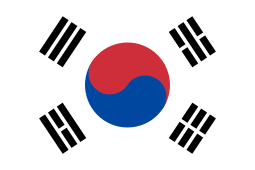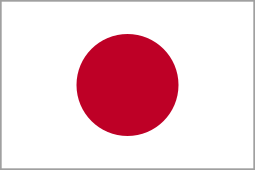Flag of South Korea
 | |
| Names | Taegukgi / Taeheukgi, (korean:태극기)Hanja: 太極旗 |
|---|---|
| Proportion | 2:3 |
| Design | white rectangular background, a red and blue Taeguk and four black trigrams |
The flag of the South Korea, also known as the Taegukgi[1] (also spelled as Taegeukgi, literally "supreme ultimate flag"), has three parts: a white rectangular background, a red and blue Taeguk, symbolizing balance, in its center, and four black trigrams selected from the original eight, one toward each corner.[2] The flag ratio is 2:3.[1]
Symbolism[change | change source]
The white background stands for purity, peace and justice. The red and blue Taeguk symbolizes absoluteness, the universe, space and its parts. The red part of Taeguk yang (which signifies bright, hot, light and positive) and blue yin (which signifies dark, cold and negative).[3] These represent the eternal philosophical categories, goodness and evilness, sun and moon, light and darkness, day and night, masculine and feminine element, move and immobility, activity and passivity, life and death.[1]
History[change | change source]
 | |
| Name | Taegukgi |
|---|---|
In 1882 the flag of Korea was adopted by Korean empire with non specified trigrams.[4] In 1882 the original design of Korean flag was designed by "Bak Yeong hyo"[5]
1910 to 1945[change | change source]
 The Korean flag under Japan's control |
During this period Korea was annexed by Japan. Which made for Japan to take over their culture and also flag during this period, and after the world 2 Korea took control of their flag again which meant on 1945 or world war 2 they have won the battle after 1945.[6]
Trigrams meaning[change | change source]
| Trigam | Meaning[7] |
|---|---|
| Heaven and justice | |
| water and life | |
| Sun and fulfillment | |
| Earth and vitality |
With 4 Trigrams together it represent principle of movement and harmony.[8]
Related pages[change | change source]
- Aegukga, the National anthem of South Korea
References[change | change source]
- ↑ 1.0 1.1 1.2 Wrona, Jerzy (2020). Flagi i herby opowiadają (in Polish). Rzeszów: Fosze. p. 112. ISBN 978-83-7586-158-7.
- ↑ Fresson, Robert G. (2020). Flaga na maszt! Przewodnik po flagach z całego świata (in Polish). Warsaw: Dwie Siostry. p. 95. ISBN 978-83-8150-097-5.
- ↑ "The Hidden Meaning Behind Yin and Yang". Culture Trip. 2018-02-24. Retrieved 2023-08-22.
- ↑ Part of the “History of National Flags” Series from Flagmakers. flagmakers.co.uk/media/ontcfk5n/flag-of-south-korea-a-brief-history-download.pdf#:~:text=The%20flag%20of%20the%20Korean. Accessed 25 Aug. 2023.
- ↑ "The History of the Korean Flag". KORELIMITED. 2020-12-23. Retrieved 2023-08-25.
- ↑ Part of the “History of National Flags” Series from Flagmakers. flagmakers.co.uk/media/ontcfk5n/flag-of-south-korea-a-brief-history-download.pdf#:~:text=The%20flag%20of%20the%20Korean.
- ↑ Mr, Paul, et al. The South Korean Flag Symbolism of the Flag. www.white-tiger-tkd.com/Symbolism%20of%20the%20flag%20white%20tiger%20%28secure%29.pdf. Accessed 22 Aug. 2023.
- ↑ Lavrov, Ilya (2021-07-27). "The South Korean Flag's Meaning | Turbologo". Design, branding and business – The Official Turbologo blog. Retrieved 2023-08-22.
